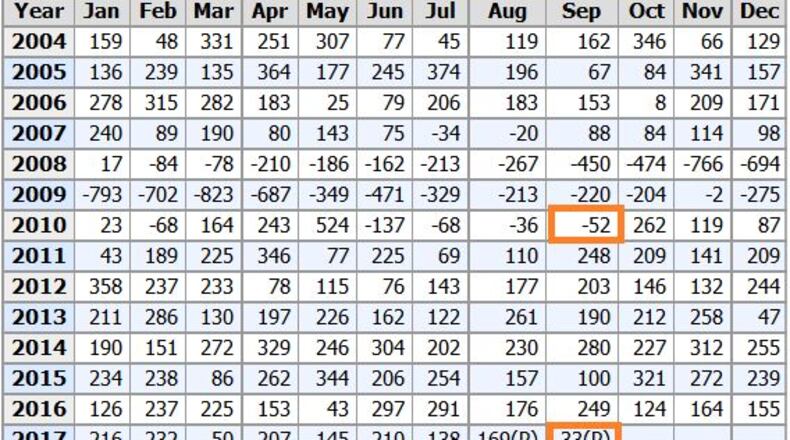1. This was the first monthly job loss since September 2010. Seven years. That's how long it had been since the monthly jobs report went the wrong way, back during the second year of the Obama Administration. The loss of 33,000 jobs means the average monthly job growth so far in 2017 is just over 148,000 jobs. At this point in 2016, the average monthly job growth was just under 200,000 jobs. At this point in 2015, the average monthly job growth was 209,000 jobs. So, it's clear that job growth so far during the Trump Administration has slowed from past years.
2. The unemployment rate headline was good. The national jobless rate dropped to 4.2 percent in September, which is the lowest since February of 2001, at the start of President George W. Bush's Administration. The jobless rate did not go down because people were leaving the labor force - instead, the size of the labor force swelled by 575,000 people, which means many more people were actively looking for a job. The Labor Force Participation rate increased to 63.1 percent, the highest since March of 2014. So, those are strong numbers, despite the 33,000 job loss. But economists have long said that the economy needs monthly job growth of over 300,000 to help restore employment to many who suffered during the 2008-2009 downturn. And we haven't been close to that.
3. The U6 rate lowest since June 2007. The broadest measure of unemployment is known as the U6 rate, which includes all unemployed, those who are working part time while looking for a full time job, and those who aren't looking currently for a job - but still want one, and have worked in the last year. That rate dropped to 8.3 percent in September, the lowest U6 rate in over 10 years. That's another good indicator about the psyche of the economy, and workers as well.
4. Where were the job losses and job gains? This is where we get into the impact of the hurricanes, according to the Labor Department. "Employment in food services and drinking places dropped sharply in September (-105,000), as many workers were off payrolls due to the recent hurricanes," the report stated. One of the strongest areas of the U.S. economy continues to be in health care, which added 23,000 jobs in September. Manufacturing was flat, which was a change from the last year.
5. GOP calls for tax reform. As D.C. digested the first negative growth jobs report in seven years, Republicans in Congress reinforced their call for tax reform legislation, arguing a cut in rates will spur new economic growth, and help the economy create more jobs. "In the weeks ahead, the Ways and Means Committee will move forward with pro-growth, pro-middle-class tax reform legislation that Congress will ultimately send to the President's desk this year, for the first time in 31 years," said Rep. Kevin Brady (R-TX). Democrats meanwhile saw something different. "The U.S. economy is not working as it should for middle-class America," said Rep. Joe Crowley (D-NY). One thing is for sure, this September jobs report was a curve ball for the markets.
About the Author
